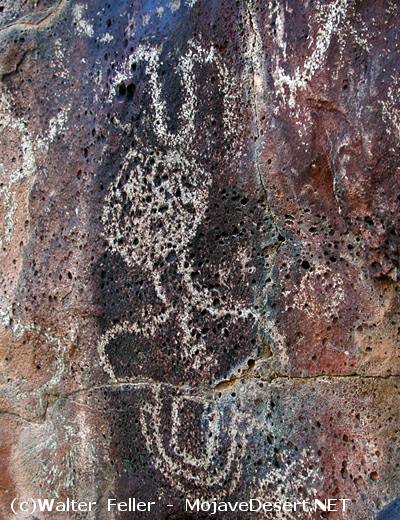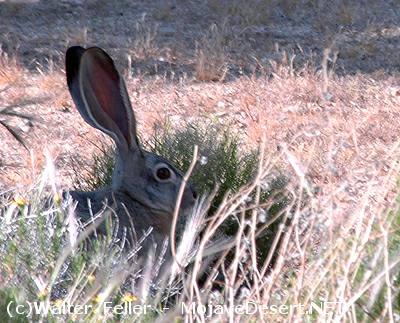Animal Resources
The use of animal food in the area now included in Joshua Tree National Park is to be covered in a proposed ethnozoology by Bean and Vane. Information on such use is scattered in the various ethnographies mentioned above under "Sources." Dorothy Ramon has provided information about how the Serrano traditionally went about procuring and using animals for food, and how they regarded the animals. For them, animals, like plants, are people who have let themselves be transformed. Ramon tells the story of the origin of deer in the following:Back in the beginning of time the Lord was living here with all the people. He was the one who asked the people whether they would turn into deer. He wanted to transform them. And they obeyed Him and were transformed. And so they were transformed. That's what He (their Lord) said. And so the deer would sing. And then the people would dance the deer dance. They would sing the deer songs. It (the song) tells about what they did, about how they were transformed. Some of them cried. Some of those animals were already transforming themselves. That is how He (the Lord) wanted it. And so they were transformed. They believed, that's why. And so they were all transformed. And so they sing to those deer who had transformed themselves. Their bodies were already completely transformed. But they still felt at home here. They were still behaving like human beings. But they had already been transformed into deer. And so they cried. They wanted to live in their homes, like human beings. There was one who kept circling about. He was looking inside, inside the (ceremonial) house. It says, that's what the song says, that he (the deer) is peaking inside and circling about. He kept peaking inside. He was looking inside the house. Some of those who had already been transformed were already wandering about outside. They had to go off somewhere else. And they climbed up into the hills. Those animals who had been transformed were destined to live in the hills forever. But they still did not know how to walk on their (newly transformed) feet. They already had hooves and were slipping along. They were not used to their (new) hooves yet. They already had hooves. That's what they did (Ramon and Elliot 2000:571-572).
Small game animals like rabbits were an important part of the Serrano diet, but there were rules about hunting them. For example, neither young hunters nor their parents could eat such animals: Ramon tells of her young brother's hunting:
Long ago I had an older brother ... my father taught him how to hunt. And he would always hunt. He would always hunt jackrabbits. When I was still small I would go around with my older brother. He had a lot of guns. My father bought them for him. He had different kinds of guns. We had them. We would walk about outside. We would hunt. But I never shot any rabbits. But he (my brother) would kill all kinds of jackrabbits and cottontailes. When he would kill one ... then we'd go home and .... But my family, my mother and father, would not eat the game that my older brother had killed, those rabbits. Long ago that was what the Indians did. My older brother was still young (under age). They did not eat the game he killed. I would eat it by myself. And so we would kill one. Then I would eat it by myself.
No one else would eat it. He himself would not eat the game he killed either. He was not old enough to eat his own game, they said. It was the same with my father and mother. They would not eat-it. They did not eat the game killed by boys. But I ... he would give it to me. I ate it by myself. That's what they used to do long ago. And I learned to hunt a little by following him around. You could get used to it and then you could always shoot things, and kill whatever you want. It was not right for a woman. That's what some people said. But some women can shoot anything. They don't care. They get used to it. They can do anything. They could kill anything. They don't care, they say. I wasn't interested. I didn't know how. At the time I too was just a little girl. And that's how it was long ago, as I said. My older brother was a hunter like my father. He taught him how to hunt all the time. He died when he was still young. He passed away (when he was 15). That's all (Ramon and Elliot 2000:483-485).
Large game animals were killed only after the appropriate rituals. As Ramon tells it:
Those par'cam hunters were trained to do that. They would appoint them like that. The paxa 'yam ('ceremonial officials') would first teach them how to hunt. When there was some religious celebration all the par 'cam hunters would go hunting. They would kill a deer or something. They would bring their kill to the ceremonial house. Some of them would sing (prayers) over it (the killed game). They would sing all night. Those people would sing about bighorn sheep long ago. They would butcher it. They would eat it. They did not just eat a bighorn sheep any old way. Long ago I saw them doing that, when they were going to hold a feast. First they would pray over it. They would sing over it. They would do all kinds of things. They would dance (round 2:30 or 3:00 a.m.). They would continue their ceremonies through to dawn. That's how they were. That's what people did long ago. I saw them with my own eyes (Ramon and Elliot 2000:485-487).
<< Previous << Contents >> Next >>
 Some of those animals were
already transforming themselves.
Some of those animals were
already transforming themselves.
He would always hunt jackrabbits